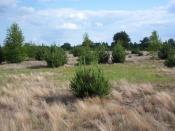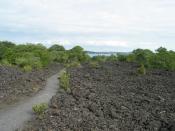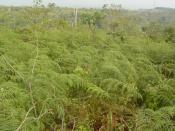Destruction or disturbance of an area of land eventually improves the area after the completion of succession. While people may find the destruction of land, due to fire, volcanoes or other natural disasters, a tragedy, in actuality the destruction brings new life to the affected area. There are two types of succession, each type experiences changes in equilibrium, primary goes through a natural progression and each can receive aid or damage by recovery mechanisms.
There are two kinds of ecosystem succession: Primary Succession and Secondary Succession. According to the text, Environment, primary succession is ecological succession that begins in an environment that has not been inhabited before. No soil exists when primary succession begins. Bare rock surfaces, such as recently formed volcanic lava and rock scraped clean by glaciers, are examples of sites where primary succession may take place (Raven & Berg, 2006). This is what we see in figure 4-4 of the text.
Figure 4-4 (a) shows the primary succession in the early stage, (b) shows the stage that took place over time, when soil has accumulated and we see grass, moss and low shrubs, (c) shows the last action in the progression, the beautiful full grown trees that have grown over many, many years. Figure 4-5 shows the growth of new vegetation in years required.
Secondary succession is the ecological succession that begins in an environment following destruction of all or part of an earlier community. Abandoned farmland and open areas caused by forest fire are common examples of sites where secondary succession occurs (Raven & Berg, 2006). As with primary succession, over time we will see the re-growth of vegetation as depicted in figures 4-4 (b & c) and 4-5 of the text.
According to our text, the environment consists of two parts; the biotic (living) environment,



Good Essay
Properly cited references and solid essay.
3 out of 3 people found this comment useful.